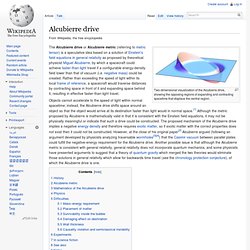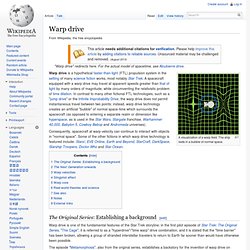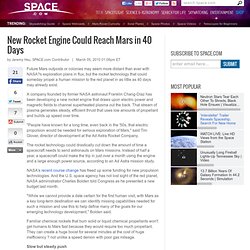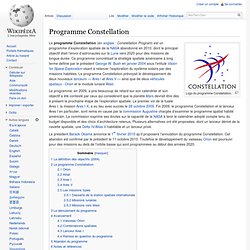

"L'humanité est une étoile, elle brille et elle s'éteint" Alcubierre drive. Two-dimensional visualization of the Alcubierre drive, showing the opposing regions of expanding and contracting spacetime that displace the central region.

The Alcubierre drive or Alcubierre metric (referring to metric tensor) is a speculative idea based on a solution of Einstein's field equations in general relativity as proposed by theoretical physicist Miguel Alcubierre, by which a spacecraft could achieve faster-than-light travel if a configurable energy-density field lower than that of vacuum (i.e. negative mass) could be created. Rather than exceeding the speed of light within its local frame of reference, a spacecraft would traverse distances by contracting space in front of it and expanding space behind it, resulting in effective faster-than-light travel. History[edit] Alcubierre metric[edit] The Alcubierre metric defines the warp-drive spacetime.
Mathematics of the Alcubierre drive[edit] where is a positive definite metric on each of the hypersurfaces. and with arbitrary parameters . Warp drive. A visualization of a warp field.

The ship rests in a bubble of normal space. Consequently, spacecraft at warp velocity can continue to interact with objects in "normal space". Some of the other fictions in which warp drive technology is featured include: Stars! , EVE Online, Earth and Beyond, StarCraft, DarkSpace, Starship Troopers, Doctor Who and Star Ocean. The Original Series: Establishing a background[edit] The episode also firmly establishes that many other civilizations had warp drive before humans; First Contact co-writer Ronald D. The Next Generation onwards[edit] Plots involving the Enterprise traveling beyond warp 10 were once in the original series (such as warp 14.1 in That Which Survives), but for The Next Generation it was decided that these would no longer be featured. Warp velocities[edit] Michael Okuda's new warp scale Slingshot effect[edit] A curious extension of warp travel, shown throughout Star Trek, is the "Slingshot Effect".
New Rocket Engine Could Reach Mars in 40 Days. Future Mars outposts or colonies may seem more distant than ever with NASA?

S exploration plans in flux, but the rocket technology that could someday propel a human mission to the red planet in as little as 40 days may already exist. A company founded by former NASA astronaut Franklin Chang-Diaz has been developing a new rocket engine that draws upon electric power and magnetic fields to channel superheated plasma out the back.
That stream of plasma generates steady, efficient thrust that uses low amounts of propellant and builds up speed over time. "People have known for a long time, even back in the '50s, that electric propulsion would be needed for serious exploration of Mars," said Tim Glover, director of development at the Ad Astra Rocket Company. The rocket technology could drastically cut down the amount of time a spacecraft needs to send astronauts on Mars missions. NASA's recent course change has freed up some funding for new propulsion technologies. Slow but steady push. Programme Constellation. Un article de Wikipédia, l'encyclopédie libre.

Logo du programme Constellation. La définition des objectifs (2004)[modifier | modifier le code] Un vaisseau spatial Orion s'approche de la station spatiale internationale (vue d'artiste) Lancement d'un véhicule spatial Orion par une fusée Ares 1 (vue d'artiste) Les vaisseaux Orion et Altair sont injectés sur leur trajectoire de transfert vers la Lune (vue d'artiste) Les lanceurs du programme Constellation comparés à la navette spatiale et à la fusée Saturn V (vue d'artiste) Le vaisseau spatial Orion en orbite autour de la Lune (vue d'artiste) Le module lunaire Altair sur la Lune (vue d'artiste) Maquette du véhicule Orion au centre Langley (2008) Le , le président des États-Unis George W.
Il est nécessaire de remplacer la flotte des navettes spatiales, vieilles de près de trois décennies, qui ont, à deux reprises, explosé en vol, tuant leur équipage, et qui sont très coûteuses à lancer. Le programme Constellation[modifier | modifier le code]